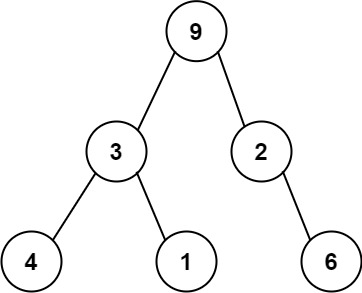问题描述
给定一个字符串,字符串是用 , 分割的数字和 #,判断该字符串是否一个二叉树的前序遍历字符串(前序遍历过程中遇到空节点输出 #),要求在判断过程中不能将字符串转换为二叉树。题目链接:点我
样例输入输出
输入:preorder = “9,3,4,#,#,1,#,#,2,#,6,#,#”
输出:true
解释:该字符串代表的树形状如下

输入:preorder = “9,#,#,1”
输出:false
问题解法
用栈来模拟树的遍历过程,如果遇到 # ,则判断当前栈顶元素是否“暴露”了两次,如果是,说明当前节点的子节点已经遍历完成,将其出栈。最后判断栈中是否为空,如果为空,则说明是一个二叉树,否则不是。代码如下
1
2
3
4
5
6
7
8
9
10
11
12
13
14
15
16
17
18
19
20
21
22
23
24
25
26
27
28
29
30
31
32
33
34
35
| class Solution {
public boolean isValidSerialization(String preorder) {
if (preorder.equals("#")) {
return true;
}
String[] items = preorder.split(",");
int[] counts = new int[101];
Stack<Integer> stack = new Stack<>();
for (int i = 0; i < items.length; i++) {
String item = items[i];
if (item.equals("#")) {
if (stack.isEmpty()) {
return false;
}
counts[stack.peek()]++;
while (counts[stack.peek()] % 2 == 0) {
stack.pop();
if (stack.isEmpty()) {
return i == items.length - 1;
}
counts[stack.peek()]++;
}
} else {
stack.push(Integer.parseInt(item));
}
}
return stack.isEmpty();
}
}
|
